Matador Network's Blog, page 1132
March 28, 2019
Versailles hosting rave this summer

In its heyday, Versailles was probably the scene of some pretty epic blowouts, but it’s likely that this is the first-ever rave to take place in the former royal palace. Versailles Electro, an event hosted by four DJs — Breakbot x Irfane, Busy P, Myd, and So Me — will take place on the terraces at the foot of the famous Hall of Mirrors and overlooking the French gardens. No doubt that Louis XIV, a lover of lavish parties, would approve.
The electronic music festival is happening on June 8 from 8:00 PM until midnight. Tickets start at $25, and can be purchased via the official website.
To make the most of your visit to Versailles, plan to check out the palace and the grounds before the dancing crowds show up. Consult our guide on how to make the most of a one-day visit to Versailles and get planning. 
H/T: Lonely Planet

More like this: Every summer music festival lineup that’s been announced so far, and who you need to see
The post Versailles will host its first rave this summer appeared first on Matador Network.

European Union scrapping DST

Bowing to popular demand for more daylight hours, the European Parliament has voted to do away with the seasonal time change. The biannual custom of changing the clocks by one hour in spring and fall will cease in Europe in 2021. While this might initially sound like great news for those looking forward to longer days, it’s not quite that simple. Although the EU will no longer require the clocks to change, each of the 28 countries of the bloc will need to decide whether they will remain on “permanent summer” or “permanent winter” time.
To stay on permanent summertime, countries would need to adjust their clocks for the last time in March 2021, allowing for more daylight hours in the evening. For permanent wintertime, countries would change their clocks for the final time in October 2021. According to a European Commission survey on the proposal, which generated 4.6 million responses, 84 percent of respondents were in favor of ending the time change. 
H/T: Lonely Planet

More like this: The 7 coolest clock towers in Europe and the stories behind them
The post EU to nix seasonal time change in 2021 appeared first on Matador Network.

Utah allowing beer over 3.2 percent

If you always felt like it was tougher to get drunk in Utah than anywhere else, you were not just imagining things. For the past 86 years, Utah has prohibited the sale of any beer containing more than 3.2 percent alcohol at grocery and convenience stores. That regulation will soon come to an end — and just in time for next year’s ski season.
Thanks to a new bill signed by Governor Gary Herbert, retailers in Utah will be allowed to sell beer containing up to 4 percent alcohol by weight, starting on November 1, 2019. The new law also applies to draft beers at restaurants and bars. Although stronger beers are available at state-controlled liquor stores, those stores are scarce, and are currently one of the only places in Utah where you can buy beer above 3.2 percent.
This might be an important benchmark for the relaxing of more beer rules in the future, but for now, it’s not getting any higher than 4 percent. Republican Senator Jerry Stevenson had originally proposed raising the limit to 4.8 percent. 
H/T: SnowBoard Magazine

More like this: These are the most beautiful breweries in Europe
The post Utah is finally allowed to sell stronger beer appeared first on Matador Network.

March 27, 2019
Best things to do and see in Xi’an

Visitors from China and around the world pass through the ancient city of Xi’an on their way to the Terracotta Army in the nearby Lintong District. While the Terracotta Army is indeed a marvel, many visitors don’t realize the bustling, modern city of 13 million has a lot to offer. With thousands of years of fascinating history and an energetic, contemporary vibe, Xi’an is worth spending a few days exploring before you check out the famous clay warriors.
Xi’an was once the most important city in China, making a visit there pretty much essential. Xi’an has been the capital to at least 13 different Chinese empires and kingdoms. Its history dates back to prehistoric times, much further back than the current capital Beijing. From being the capital of ancient feudal cities to the first capital of a united China in 221 BC, then to numerous dynasties and kingdoms, and now a thriving modern city, Xi’an’s history runs deep. Notably, Chang’an (Xi’an) was the capital during the powerful Tang dynasty from 618 to 904 AD, and served as the eastern end of the Silk Road — the important trade route connecting China to the Middle East and Europe. At that time, Chang’an was the largest city in the world and home to one of the most progressive empires.
With the Chinese high-speed rail system, it’s comfortable and cheap to travel to Xi’an from any other major Chinese city. Once in Xi’an, its efficient and rapidly expanding public transit can get you to all the major sites, and you will be pleasantly surprised by how the subway and roads are better kept than in many cities in the US. From magnificent drum towers to tranquil pockets of nature, here’s everything you need to see on a trip to Xi’an.
Giant Wild Goose Pagoda

Photo: posztos/Shutterstock
The Giant Wild Goose Pagoda was built in the Tang Dynasty of China and is one of the last few remaining pagodas that covered the ancient city of Chang’an. Monk Xuanzang, the first abbot of the surrounding Da Ci’En temple made a 17-year pilgrimage to India to bring back ancient Buddhist relics and Sanskrit texts. Sitting tall atop a hill surrounded by trees and ancient buildings, the well-kept ancient structure is an imposing site.
The surrounding area is equally appealing. Every night, the whole area is lit up with bright colors coming from all sides. The North Square has one of the largest fountains in Asia and an evening water show. On the South Side, across from a square with a statue of Monk Xuanzang is the Great Tang All Day Mall. This walking strip is the perfect place to spend an evening with an abundance of public art celebrating one of the most important and progressive Chinese dynasties, bright lights, and shopping. While there, grab a bite to eat, stop to dance with a live DJ, and maybe spontaneously decide to take in a Chinese opera at the Opera House located on the walk.
Small Wild Goose Pagoda

Photo: Anton_Ivanov/Shutterstock
One of the most well-preserved pagodas from the Tang dynasty times, this temple was built in 701 to hold Buddhist texts brought by Monk Yi Jing in a pilgrimage from India. Continual renovations have maintained the original structure, and its unique architecture and details are just as interesting as those of its bigger sister, the Big Wild Goose Pagoda. While damaged with a crack from the earthquake in 1556, the majority of the structure is still in good shape.
Within walking distance is the Xi’an Museum. The Xi’an Museum has an astounding 130,000 relics starting in the 11th century BC all the way through modern history. You can compare relics side-by-side from one dynasty to the next and revel at the richness of Chinese history. As you observe incredibly well-kept items and imagine their original uses, it’s easy to forget that many of the items are literally thousands of years old. While not as famous as the Shaanxi History Museum, Xi’an Museum is slightly less crowded and nearly as impressive.
Daming Palace

Photo: Dashu Xinganling/Shutterstock
Daming Palace is three times the size of Versailles, four-and-a-half times the size of the Forbidden City, and 15 times the size of Buckingham Palace. Daming Palace is huge. Excavated in the 1950s, it is the ruins of what used to be the magnificent Imperial Palace of the Tang Dynasty, from the years 618 to 907.
While nowadays none of the original buildings made of wood remain, visiting the site can still give you a feel for the magnificent size and history of the palace. Daming has numerous exhibits that help visitors understand the palace better, including an underground museum built beneath the ruins, which celebrates the history of the palace with artifacts and maps.
Muslim Quarter

Photo: RPBaiao/Shutterstock
During the Tang Dynasty, Xi’an was the end of the Silk Road, which led the city to be heavily influenced by Arabic culture. In the historic Muslim Quarter of Xi’an, stop by the Great Mosque in the Muslim Quarter. The mixture of Chinese and Arabic influences is particularly pronounced in the unique architecture and the Grand Mosque’s long history. A tour will teach you more about the similarities and differences between the ancient Chinese Islam of Xi’an and that of the rest of the Islamic world.

Photo: Marisa Estivill/Shutterstock
Xi’an’s food is famous for its Arabic influence, and there’s no better place to enjoy this unique cuisine than the Muslim Quarter. Lining the busy walking streets, you’ll find food vendors selling delicious Xi’an foods like lamb PaoMo, a bread crumb soup dating back to the Tang dynasty; Chinese hamburgers; kebabs; and biang biang noodles, a tangy and peppery dish that’s specific to Xi’an. The best restaurants are typically found off the main streets.
Bell and Drum Towers

Photo: Chinasong/Shutterstock
The Bell Tower, built during the Ming Dynasty in 1384, is one of the most impressive preserved bell towers of its time. In the geographical center of the city at an intersection, the tower dazzles with its bright colors and ancient architecture. While walking around the outside, take in the sweeping view of the modern city. Inside, you can find several large bronze bells from the Tang dynasty, as well as ornately decorated rooms filled with Chinese designs.

Photo: Anton_Ivanov/Shutterstock
The Drum Tower is similarly striking. Its visible from the Bell Tower, and you can travel there within a five-minute, mostly underground walk to avoid the extreme Xi’an weather. Also built in the Ming Dynasty, it got its name from the huge drum located inside that used to be drummed when the sun set. While visiting the Drum Tower, you can easily lose track of time getting entranced by the regular musical performances.
Xi’an city walls

Photo: gyn9037/Shutterstock
Xi’an is one of the few Chinese cities to have preserved its historical city walls. Originally built during the Tang Dynasty — and rebuilt and restored numerous times since — the Xi’an city walls are a great place to get a feel for the city.
If you can, rent a bicycle and do the entire hour-and-a-half-long bike ride to get the full experience. Along the way you can see guard towers and different imposing main entrance gates while also observing details — such as a slanted ground to prevent flooding. As you bike, you will notice that the more historical, preserved buildings lie inside the city walls, while the area outside the walls reflects a more modern city of endless high rises.
Tang Cultural Paradise Park

Photo: LP2 Studio/Shutterstock
Located in the wealthier neighborhood of QuJiang, Tang Cultural Paradise Park is a fun place to enjoy a day at the park while also learning more about the history of the Tang Dynasty.
Tang Cultural Paradise Park is modeled after the Emperor’s gardens during the Tang Dynasty, one of the peaks of Chinese civilization, and is one of the most beautiful places in all of Xi’an. Throughout the park are recreations of Tang Dynasty buildings, with architecture from that time and actors in costume. If you climb to the upper levels of the taller buildings, you can catch views of the urban Xi’an that surround the park and of the Giant Wild Goose Pagoda.
As a park, Tang Paradise Park is clean and peaceful, and offers a lot to do. About half the park is a lake, and you can walk amongst the willows as you go from exploring one Tang dynasty building to the next. If it’s summertime, you can stop for ice cream to cool down in the shade by the lake or take a paddleboat out onto the water. In the evening, regularly scheduled performances recount the history of the Tang dynasty; these are followed by spectacular light shows.
QuJiang Book Store

Photo: Natasha Salmi
While travelling in China, you may find yourself needing a new book to pass the time during the hours spent on bullet trains travelling from city to city. Across the street from the Tang Dynasty Paradise Park, Qu Jiang book store is the perfect place to pick one up. It’s modern and, if you’re fed up with Xi’an’s sweltering summer heat, an air-conditioned oasis. Qu Jiang Book Store is three floors and each is filled with books in all languages. In addition to countless books, it also has a kids arts and crafts area on the third floor, a garden store, and even a hair salon.
Once you’ve bought your books, across the street and right next to the Tang Dynasty Paradise Park are tons of delicious, local-favorite restaurants. A few I’ve eaten at and enjoyed were 荷唐壹号, hot pot; 佰人王串串香火锅(大唐芙蓉园店), hot pot but with your food on sticks; and 大唐回珍楼(芙蓉南路), traditional Xi’an and Chinese food.
Shaanxi History Museum

Photo: zhu difeng/Shutterstock
If you haven’t overdosed on Xi’an’s rich history by now, Shaanxi History Museum will put you over the edge — in a good way. While it can be pretty busy during peak times, Shaanxi History Museum still hosts a jaw-dropping collection of artifacts chronicling the history of Shaanxi province in Northwestern China. The map of history it paints is incredible, with over 370,000 items from prehistoric times to about 1840 BCE.
The murals, intricately decorated preserved pottery, and gold and silver items will blow you away, especially since so many of the objects you’ll see are well over a thousand years old. The Museum is modeled after Tang architecture, with numerous wings focusing on different eras of history, and English tours are available. If you’d rather go it alone, you can still spend all day reading the signs and enjoying the splendor of ancient China.
Hua Shan

Photo: Rat007/Shutterstock
An hour outside of Xi’an is breathtaking Hua Shan and the surrounding range. Steep and rocky, with jagged peaks and lush greenery in the wetter months, they really are dramatic. In addition to the stunning mountain views, Hua Shan is one of the five sacred Taoist mountains in China, with different temples and shrines at its peak.
It’s also the site of one of the most dangerous hikes in the world. Hua Shan has a cliff-side mountain hiking trail that involves a six-hour trek; clipping into cables; and walking across sketchy, nailed-together planks alongside a sheer cliff face. It is said that hundreds of people fall fatally each year. Needless to say, you shouldn’t hike Mt. Huashan without a guide and prior climbing experience. Thankfully, if you aren’t willing to risk your life, you can still experience the mountain scenery — and the tea house on top at over 7,000 feet — by heading up on the safer, albeit still rickety, gondola. 

More like this: The best hiking in China
The post The best things to do in Xi’an beyond the Terracotta Army appeared first on Matador Network.

Vibrant Vegan Co travel and food job

Eating local is one of the best parts of traveling, and now you can actually get paid to do it. A UK food subscription company is looking for a “Director of Taste” whose job will be to travel the world, try new foods, and report back on your experiences to the company. All accommodation, travel, and food expenses will be covered, in addition to a salary of $66,000 and 28 days of vacation each year (as if the job itself isn’t already enough of a vacation). There’s just one catch though: The food will be vegan-friendly.
While travel jobs surrounding eating usually feature indulgent foods like chocolate or BBQ, Vibrant Vegan Co. will have their employees scouring the globe for healthy, plant-based ingredients. You can expect to spend up to four months at a time, 35 hours per week, visiting countries like Japan, India, China, Turkey, Chile, Mexico, and others, discovering new ingredients and recipes. Thankfully, many of these countries have naturally healthy cuisines, featuring amazing traditional vegan dishes without sacrificing flavor or satisfaction. The successful candidate will also be required to help set up overseas partnerships to facilitate the sourcing of new ingredients for Vibrant Vegan Co.
To apply, candidates must have at least three years’ experience in the food business and pass a rigorous interview process including an in-house taste test where your taste buds will be under scrutiny. Iain Burke-Hamilton, founder of Vibrant Vegan Co., said, “I don’t think we’ve ever recruited for a job this exciting before. This is a very unique and rewarding job but despite its extensive perks, we acknowledge it’s also very demanding.”
Of the company’s expectations, Burke-Hamilton added, “We hope our new recruit will be able to inspire some new and tasty recipes for our vegan-ready meal offering.”
To apply, follow the directions on the official website. 
H/T: Insider

More like this: 11 vegan food tours around the world that even meat-eaters will love
The post This company will pay you $66,000 a year to travel the world tasting healthy food appeared first on Matador Network.

Largest Passover Seder is in Nepal

Passover is one of the most important Jewish holidays, and the Seder on the first two nights is a celebration of food, wine, and biblical stories. But the biggest celebration isn’t in Israel — it’s in Nepal.
Last year, Nepal’s capital of Kathmandu celebrated its 30th anniversary of hosting the world’s largest Seder. The first was organized by then-rabbinical students Mendel Kastel and Mendel Lipskier in 1989 when they were attending yeshiva in Australia. Israel’s ambassador had put out a notice of a Seder at the embassy, but when too many people signed up, he asked for help. Katel and Lipskier answered the call and took on the duties of ensuring all the food was kosher and enough unleavened bread, wine, and gefilte fish was brought into the country. All the while, the list of attendees continued to grow. The original 90 people turned to 100, then 200, then more. They secured a larger space outside of the embassy, and they used doors from a nearby hotel that was under construction as tables. In all, 500 Jewish people showed up from around the world.
Now, 30 years later, the tradition continues. The Seder is organized by Chabad House Nepal, with the Israeli embassy assisting with the import of kosher foods and other supplies. For Jewish people traveling abroad, a Passover Seder is one of the best ways to connect with the global Jewish community.
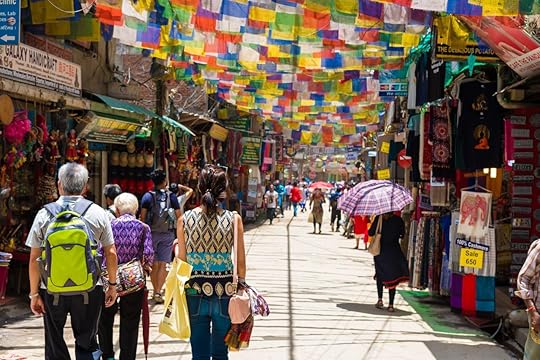
Photo: Constantin Stanciu/Shutterstock
The holiday centers around the Biblical story of the Israelite exodus from Egypt. In the story, God wrought 10 plagues upon the Egyptian pharaoh until he agreed to free the Israelites, and Moses parted the Red Sea to lead them to the Promised Land. The name “Passover” refers to the 10th plague, in which God killed all the Egyptian firstborn children but passed over those who were Israelites. The Israelites left Egypt for the promised land. They left so quickly that the bread for the journey didn’t have time to rise. Today, feasts are held on the first two days of Passover, when the story of Exodus is told and retold and tables are filled with unleavened bread, kosher wine, and bitter herbs.
Passover is celebrated around the world. The feast in Kathmandu is so well attended, however, because of the many Israeli backpackers who travel through the country after their required army service from 18 to 21 yet before they attend university. Nepal has long been a popular travel spot because of its low cost and wealth of outdoor activities like hiking, rafting, and bungee jumping. This has lead to a prominent, if unexpected, Jewish cultural presence in the Nepali capital.
Community Seders and Jewish influence aren’t just in Nepal’s capital city, either. While the largest takes place in Kathmandu and regularly sees between 1,000 and 1,500 people, a second is held in the city of Pokhara in central Nepal, with a few hundred guests. A third — called the “highest Seder in the world” — is in Manang, a town in the middle of the Himalayas, with around 200 people attending.
Passover lasts a full week, and the Seder takes place on the first and second days after nightfall. In 2019, Passover is from April 19 to April 27. Keeping the Seder running smoothly each year, however, is never easy. Rabbi Chezki and Chani Lifshitz, who have co-directed the Chabad Center and run the Seder since 2000, admit that shipping Seder goods to Nepal is often a struggle. Nepal was in the midst of a civil war from 1996 to 2006, and goods were stopped by both the government and rebels. Trucks have broken down en route from Israel, and the goods had to be helicoptered in. Closed borders in 2008 led to a shipment that just barely made it in on time.

Photo: Nitipol Temprim/Shutterstock
Kathmandu’s Seder has had an impact on Jewish life in Nepal, where an overwhelming majority of residents are Hindu, followed by Buddhist or Muslim. The Seder’s success has been a catalyst for a growing Jewish presence in the region, with Chabad centers cropping up across the continent following Kathmandu’s example and providing a cultural anchor for Jewish backpackers.
For a celebration that’s typically held in the privacy of homes with friends and family, there’s nothing quite like Seder in Kathmandu. 

More like this: 7 Jewish treats the world needs to know about
The post The world’s largest Passover Seder is in Nepal appeared first on Matador Network.

Traditional northern Thai cuisine

Visit a Thai restaurant in the US and you’re likely to see yellow curries and pad prik khing next to drunken noodles and pad thai. Fine dishes in their own right, but many of Thailand’s best recipes actually come from in and around the northern city of Chiang Mai. Northern Thai recipes aren’t as well traveled as their southern counterparts, often making it tougher to enjoy a hearty bowl of khao soi the further you are from the area. Which makes a visit to the region all the more worth it for the culinary inclined.
Meals in Chiang Mai are cheap, and quality street vendors are as plentiful as the vibrant cafes and restaurants that line the fortified city center. The modern city extends far beyond the original enclosed space, so do yourself a favor and venture out when seeking these seven dishes. Your taste buds will thank you.
Sticky rice

Photo: WhyMePhoto/Shutterstock
You’ll be laughed at if you tell someone you’ve been to Chiang Mai but haven’t tried mango and sticky rice (khao niaw). Northern Thais call their cuisine isaan or lanna, terms that have lived on since the Kingdom of Lan Na ruled the region from the 13th to the 17th century. Chiang Mai was established in 1296 to serve as the kingdom’s capital, and today, the city is both the cultural hub of northern Thailand and a popular backpacking stop for travelers trekking through Southeast Asia. Sticky rice is the culinary staple of northern Thailand, a unique grain that’s heavy on gluten and low on amylose. On its own, the taste is quite bland to western palates, but when paired with the sweet and dominating flavor of mango or a heavy grilled protein, you have a street dish that fills you and a partner up with just one order. The best place to try sticky rice is at Chiang Mai’s famous night bazaar, which happens nightly at the intersection of Tha Pae and Chang Klan roads.
Khao soi

Photo: YDG/Shutterstock
Khao soi might just be the greatest thing ever put into a bowl. The dish consists of thin rice noodles with braised chicken served in a spicy coconut curry broth, and the whole thing isn’t shy on shallots and garlic. The broth is kicked up with shrimp paste and topped with a garnish of fried wonton noodles, cilantro, and lime juice, with some places opting to add shrimp and/or pickled veggies into the mix. Khao soi resembles southern curry dishes in a few key ways, like its creaminess and the option to swap chicken for pork or go vegetarian, making this a great way to introduce yourself to northern Thai cuisine. The dish is popular across northern Thailand, as well as neighboring Myanmar and Laos.
Kaeng hang lei

Photo: tavizta/Shutterstock
The rich pork curry known as kaeng hang lei is a common meal served in cafes across Chiang Mai and the northern province. It’s heavy on garlic, turmeric, ginger, and tamarind, making it vaguely reminiscent of the curries of Myanmar and India. The dish is less spicy than most in northern Thailand though those unaccustomed to hot foods will definitely notice a kick.
Kaeng kanung

Photo: White_Cloud/Shutterstock
Kaeng kanung is a curry dish made from unripe jackfruit and cherry tomatoes. Jackfruit is one of the most versatile veggie substitutes for meat in many Asian dishes, though kaeng kanung is typically also served with pork (though you can find places that serve the dish sans-meat). The sourness of kaeng kanung makes it somewhat similar to khao soi.
Ant egg tom yom

Photo: Watit Wongla/Shutterstock
If you’re traveling with someone who’s insect-averse, maybe don’t tell them that those little white bean-looking things in the soup appetizer you ordered are ant eggs. At least not until after dinner. Ant egg tom yum is served in certain restaurants across Chiang Mai frequented by Thais and travelers accustomed to the culinary styles of the region. The soup’s flavor is dominated by the broth and cooked vegetables in the soup. You’ll hardly taste the red weaver ants, though they may pop in your mouth similar to the way fine caviar does. Red ants are commonly served atop salads in northern Thailand, as well, and they’re renowned for their medicinal benefits.
Chiang Mai sausage, or sai qua

Photo: Plaawhale bigfish/Shutterstock
Cook pork sausage with chilies, galangal, lemongrass, and lime leaves and you have sai qua, which translates to stuffed intestine and is commonly known by westerners as Chiang Mai sausage. Sai qua is salty and spiced with red curry paste, and it’s a common street food served by vendors in Chiang Mai and throughout northern Thailand. The sausage is typically accompanied by sticky rice or veggies.
Khanom jeen nam ngiao

Photo: abinkung/Shutterstock
Khanom jeen nam ngiao is northern Thailand’s take on tomato curry. Anchored by shrimp paste, lemongrass, and dried chilies, the dish is served with rice noodles and spicy pork balls. The broth itself is a staple northern Thai delicacy, but add in a serving of coagulated pig blood and pickled cabbage, bean sprouts, and fried pork skin, and it takes on a flavor all its own. 

More like this: The definitive guide to the best street food in Thailand (and where to find it)
The post Thailand’s best dishes are found in Chiang Mai, not Bangkok appeared first on Matador Network.

Best wildflower blooms in the world
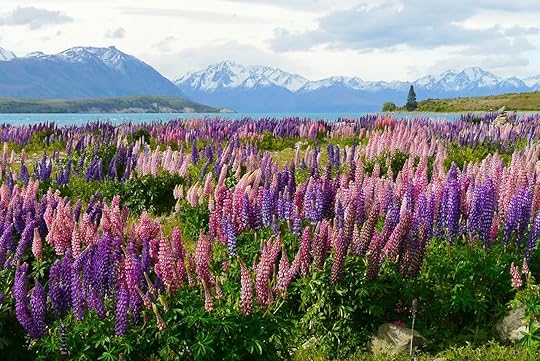
It’s officially spring in the Northern Hemisphere, as the recent super bloom in California has made loud and clear. But the Golden State’s golden poppies are just the beginning. This time of year, wildflowers carpet landscapes north of the equator across the globe, from the hills of Texas to the mountains of Bhutan. Then the whole thing starts up again in September when spring hits the Southern Hemisphere — it’s almost always wildflower season somewhere. Here are seven stunning blooms worth traveling the world for.
1. English bluebells — United Kingdom
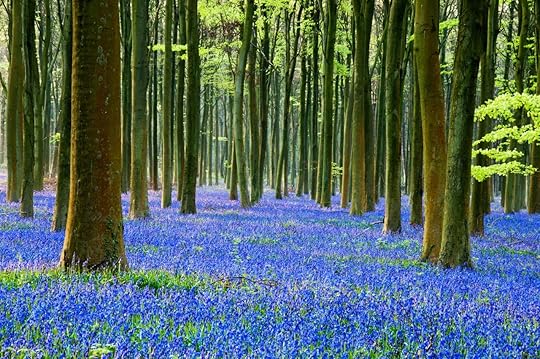
Photo: J Need/Shutterstock
All across the UK, bluebells begin blooming midway through April, and they don’t let up until May. The purplish, perennial flower blankets ancient woodlands from Northern Ireland to Wales to the British Isles, but the best place to see them is their namesake nation: England. Some of the top spots are a doable day trip from London, including Kent and the Chilterns. If you’re in the East of England, head to Norfolk or Suffolk; consider Nottinghamshire in the Midlands; or opt for Yorkshire, Cheshire, or Lancashire in northern England. The National Trust has a comprehensive list of the best bluebells walks no matter where you are in the UK.
2. Namaqualand daisies — South Africa
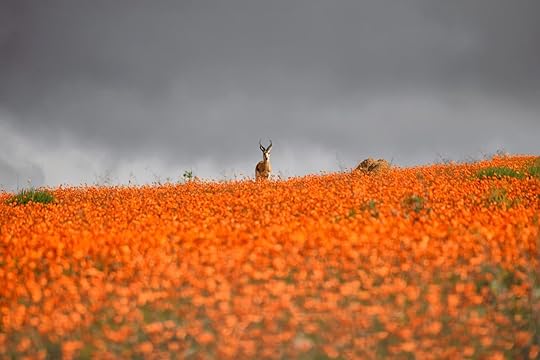
Photo: Cathy Withers-Clarke/Shutterstock
Something magical happens in August and September near the Namibia–South Africa border: The orange, arid sands of the Namaqualand desert are replaced by even brighter orange daisies. Yellow, pink, red, purple, and white daisies decorate the landscape, as well as a variety of other wildflowers. The official Namaqualand Flower Route starts about five hours north of Cape Town and cuts through the towns of Garies, Springbok, Kamieskroon, and Port Nolloth. Interspersed are protected spaces with hiking trails where visitors can stretch their legs and see the flowers up close. Get an early start when if you go as the blooms only open when the sun’s out between 10:00 AM and 4:00 PM.
3. Rhododendrons — Ireland

Photo: FRDMR/Shutterstock
Rhododendrons have been widespread in Ireland since they were introduced to the island in the 18th century — much to the chagrin of conservationists. The then-exotic, pink-purple Rhododendron ponticum species was brought over from the Iberian Peninsula to spruce up Britain’s parks and gardens, and it’s been growing aggressively ever since. Nowhere is the problem greater than Killarney National Park, where the prolific blooms notoriously choke out the native flora. So badly, in fact, that in 2017 a Kerry politician even suggested military intervention.
Killarney National Park is hardly your only option for spotting this beautiful yet invasive species. The scenic drive down Vee Pass in County Tipperary is known for its rhododendron cover come spring, as is Reenagross Park in the town of Kenmare, where visitors might even discover a romantic natural rhododendron tunnel. Stop by any of the above between mid-May and mid-June to see the flowers at their finest — before Ireland figures out a way to deal with its rhododendron problem.
4. Lupins — Lake Tekapo, New Zealand

Photo: Blue Planet Studio/Shutterstock
Lupins, or lupines, grow all around New Zealand, but the flowers that ring the South Island’s Lake Tekapo are the real scene-stealers. They bloom between mid-November and December, which is summer in the Southern Hemisphere. It’s an event that draws tons of visitors every year. While the tourism benefits locals — and the flowers are undeniably beautiful — the pink, purple, and blue plants aren’t quite as nice as they look. Lupins are an invasive species that grow aggressively around the Mackenzie Basin, threatening some native species and ecosystems. Lupins also grow abundantly in Iceland, where they are an invasive species, too.
5. Bluebonnets — Hill Country, Texas

Photo: kan_khampanya/Shutterstock
Texas’s Hill Country has been in the news lately due to this year’s bluebonnet explosion. While the almost-purple wildflower puts on a good show every year, Big Bend National Park is seeing its biggest and brightest bloom in a decade. Elsewhere, you’ll get an eyeful in the fields around Fredericksburg, Marble Falls, and Ennis, home of the Lone Star State’s official bluebonnet trail. It’s a pretty special sight, so if you can’t make it down to Texas in the next few weeks, be sure to put a wildflower-viewing excursion on your bucket list for some other March or April.
6. Marigolds — Uttarakhand, India

Photo: Olga Lipatova/Shutterstock
Though the Himalayas typically conjure images of snowy peaks, pockets of mountainous northern India also see stunning wildflower blooms between June and October. So stunning in the case of Uttarakhand’s Valley of Flowers National Park that the alpine flora helped earn the West Himalayan valley a UNESCO nod. Beautiful orange marigolds are a common sight though hundreds of species bloom in the park, including various orchids, poppies, lilies, and daisies. Visit in August or September when the flowering season is at its peak thanks to the heavy monsoon rains. Note that visitors are only allowed in the park during daylight hours.
7. Cherry blossoms — Japan and Washington, DC

Photo: Sean Pavone/Shutterstock
Locals and travelers alike anxiously anticipate cherry blossom season in Japan and Washington, DC, every spring, which generally peaks in March or April in both locations. In Japan, where the blossoms are known as sakura blooms, some of the most ambitious buds will open up as early as January. The island of Hokkaido and former capital Kyoto are two of the popular spots for sakura viewing. Stateside, the nation’s capital fills with cherry blossoms both on and off the National Mall. Book a last-minute trip to DC before April 14 to catch this year’s National Cherry Blossom Festival and see the delicate pink and white blooms framing some of the US’s most iconic monuments. 

More like this: The 7 most fascinating flowers around the world you need to see in person
The post The 7 most stunning wildflower blooms in the world and when they peak appeared first on Matador Network.

Best places to learn to surf in 2019

It’s time. You’ve wanted to learn how to surf since watching Point Break in the early ’90s, and the cold truth is that if Keanu Reeves can do it, you can do it too. Lucky for you, with the opening of new surf schools and cheap flights to popular surf destinations, learning to surf has never been easier. Pack up those boardshorts and grab a wetsuit because 2019 is the year you’re finally going on a surfari. Here’s where to do it.
Where to paddle out and get comfortable
Santa Cruz, California

Photo: Sundry Photography/Shutterstock
Last year, California made surfing the state’s official sport. The move was an appropriate one, as Californians and visitors alike take to the waves constantly up and down the state’s 840 miles of Pacific coastline. Among the best places to learn in the state are Cowells Beach and Capitola Beach in Santa Cruz, where the waves gently rise and take their sweet time to “break” with the whitewater curl you need to propel yourself forward — meaning you have plenty of time to position yourself on the wave. Also, since you’re over a reef, the wave breaks in more or less the same spot every time, making wave selection a lot easier.
Also, since this is a well-known beginner spot, the vibe is a lot more chill than at other peaks along the Santa Cruz shore. You could join the droves of beginners and make your newbie foibles among dozens of others doing the same thing, but your best bet would be to visit these beaches during spring and autumn after the summertime crowds have left and the kids are back in school. (At any time of year, you’ll want a 4/3 wetsuit, and the O’Neill surf shop is conveniently located on 41st Avenue.) These breaks are ideal for bailing out of the Bay Area on a day trip to the beach, as well, as Santa Cruz is just an hour and a half from the heart of San Francisco.
Best beginner wave: Capitola Beach and Cowell’s, both easily accessible from town
What else to do: Visit Natural Bridges State Beach, which houses a beautiful butterfly preserve as well as the rock bridge that made it famous. This state park is also among the best spots in the area to spot a seal. The Santa Cruz Wharf and Santa Cruz Beach Boardwalk are your spot off the sand, with shopping, dining, and rides.
Ditch Plains — Montauk, New York

Photo: rj lerich/Shutterstock
Ditch Plains is where New Yorkers go to learn how to hang ten. Long Island has a more laid-back, casual vibe than Manhattan or Brooklyn, and combined with the mellow waves of spring, summer, and fall, this is a great place to learn how to surf without having to travel to do it. The beach break is long and expansive across Ditch Plains Beach, allowing plenty of space for you to paddle out cautiously and get comfortable. White sand runs into cloudy blue water and creates a scene of striking visual contrasts, and surfers in black wetsuits tend to look like seals working their way down the wave.
Experienced surfers tend to line up further east of the beginner’s break, though you’ll encounter a minor crowd if you visit on a weekend or a warm, sunny summer day. The water can be quite cold depending on the season, so be sure to rent a wetsuit along with your board, both of which you can grab in town at Air and Speed. In the summer, you can usually get by with a shortie wetsuit, and you definitely won’t need thicker than a 3/2.
After your morning surf, Joni’s is awesome for a healthy lunch. But be warned: As good as that lunch may be, accommodations in Montauk are expensive — making the area a great place to also work on your #vanlife skills.
Best beginner break: Near Rheinstein Estate Park
What else to do: If the weather is on your side, keep outdoors and check out Long Island’s extensive collection of hiking trails. Montauk proper has an excellent restaurant scene that expertly blends Long Island’s Italian heritage with the flavors of the ocean just offshore. Before sunset, head to the Surf Lodge for live music and drinks.
Where to dive in
Malibu Popoyo — Costa Esmeralda, Nicaragua

Photo: Malibu Popoyo
If long, gentle waves flowing into soft sand beaches and a local beach culture with hints of both the Wild West and a Rasta-fied summer camp calls to you, Nicaragua is where you want to be for your first surfing experience. As the country works to recraft its image to tourists following recent bouts of social strife, a number of hot new attractions have popped up to showcase the Pacific coastline. Many of these are boutique surf retreats catering to rise of the eco-tourism that has taken hold in the Caribbean. Malibu Popoyo is the cream of the crop, a new surf school and lodge with guided access to 10 world-class surf breaks, including the classic break of Playa Santana right outside its front door.
The setup is all-inclusive, with an onsite restaurant and bar, a yoga palapa, and a pool. What makes Malibu Popoyo ideal for beginners is the pro guide that escorts you to the breaks, with daily access to mellow longboard cruisers perfect for finding your footing on the board. The only thing you need to watch out for is the bar tab back at the lodge, the one exclusion to the resort’s all-inclusive mantra.
Best beginner wave: Playa Santana
What else to do: Relax. Costa Esmeralda is a sleepy, slow-moving kind of place. Locals long ago adopted the mantra that “what can be done today can also be done tomorrow.” Have a surf, then tuck into a good book on the beach, preferably with a glass of chicha in your hand. You’ll stick out like a sore thumb if you’re in a hurry.
Nosara, Costa Rica
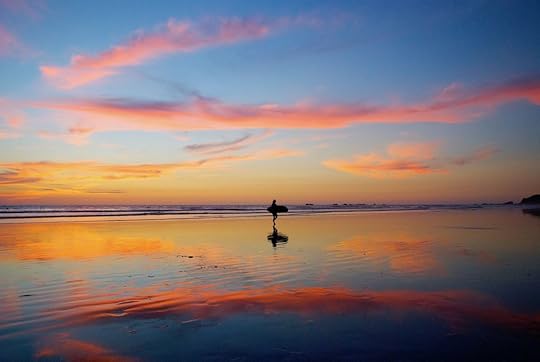
Photo: Noelle Alejandra Salmi
Nosara, on the western edge of Costa Rica’s Nicoya Peninsula, is home to a great beginner wave on Playa Nosara that has drawn a number of surf schools to its shores with one goal: getting first-timers in the water and standing up on a surfboard. Here, you can stay in a luxury accommodation and receive professional instruction at resorts like Surf Simply, which offers video instruction courses along with personalized teaching both in and out of the water. In true Pura Vida style, they also give you smoothies during the lesson and have helped cultivate a surf scene that perfectly embodies the country’s laid back spirit.
Nosara is also home to a strong female surf scene including women-only surf retreats and the Nosara Ticas Surf Club, a group that helps women learn to surf in a supportive environment. A typical day on the beginner wave here sees riders of all ages and backgrounds, and even if the surfing isn’t enough to get you hooked, the turquoise water should do the trick.
Best beginner wave: Playa Nosara
What else to do: Lots of yoga. Nosara is a wellness haven, and an early-morning stroll through town will lead you past numerous yoga studios filled with locals and tourists deep into their Ujjayi breath. Join a class or head down to the beach to work on your solo practice. You can also visit rescued animals at SIBU Sanctuary.
Vila Nova De Milfontes — Alentejo Region, Portugal
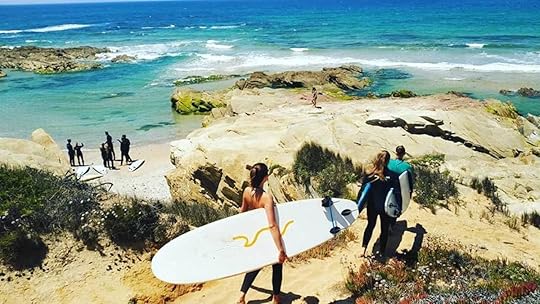
Photo: Alentejo Surf Camp/Facebook
The idea of surfing in Portugal can be an intimidating prospect, considering that this western European nation is home to the skyscraper-sized waves of Nazaré. Certainly, any first-timer would be right to fall into a panic attack at the thought of paddling out to an 80-footer. To quote every surfer of all time, “Just chill, bro.” Head about three and a half hours south of Nazaré to the Alentejo Region, where you’ll find a collection of cozy, welcoming surf schools and a series of rippable beginner waves.
At the north end of Alentejo Natural Park, Alentejo Surf Camp houses up to 20 people hostel-style in its villa. Its instructors guide you through the basics of paddling and standing up on small waves and then send you back to the villa to take advantage of a private bar to relax in and sort through the day’s photos.
Best beginner wave: São Torpes, at the far north end of the park, is an uncrowded and simple wave to learn on. If you’re with the surf school, they will likely take you to closer waves, but by venturing only about 20 minutes north, you’re stepping away from many of the tourists visiting the park.
What else to do: Eat. For being such a small beach town, Vila Nova De Milfontes has some incredible cafes specializing in fresh Portuguese cuisine as well as lighter options made with local produce that are perfect for a day at the beach. Do lunch at 18 ePiques, visit local markets, and when it’s time for petiscos, or tapas, head to Ritual.
Kuta — Bali, Indonesia

Photo: GlebSStock/Shutterstock
Bali is paradise in nearly every sense of the word. Wide open beaches lined with mellow cafes and bars ring the southern portion of the island, while an hour’s drive from the coast puts you among the monkeys and yogis of Ubud. While experienced surfers hang out at Canggu’s Echo Beach and in the swells of Uluwatu, Kuta is home to easy beginner breaks that don’t sacrifice the turquoise water or the health-and-wellness scene that this Indonesian island is so well known for.
The cool thing about surfing in Bali is that the scene here embodies the carefree surfer’s mentality. Rent a surfboard from a guy on the beach — this should cost you about $5 for an hour and requires no paperwork or signatures of any kind — and paddle out with your crew. Or, go the more formal route and take a lesson through Odyssey Surf School.
Best beginner wave: Kuta Beach, within walking distance or a short motorbike ride from anywhere in town
What else to do: Due to a consistent flow of young backpackers, Kuta has a hopping nightlife scene. After your session on the water, start with a Bintang beer at a beachside cafe, and then move into one of the many “beach clubs” as the evening progresses. Here you’ll find DJs spinning top 40 and dance tunes to a crowd of people alternating between dancing and poolside lounging. Get there early because there’s nothing better than watching the sunset over the water from a beachside infinity pool, cocktail in hand.
Surf Yoga Beer — Various locations

Photo: Surf Yoga Beer/Facebook
You’re probably already skilled at one of these three things — wave-riding, asanas, or brew-drinking — and this is your chance to learn the other two. Surf Yoga Beer promises “fitness adventures worldwide” with professional instruction and a crew of people who apparently party just as hard as they work out. The trips are all about building a positive and supportive community around travel, culture, and surfing. Adventurers come with various levels of surfing experience — from just starting to advanced.
You’re likely to glean tips from surfers slightly more experienced than you and, as long as you’re not a dick, they’ll probably even take you out and help you get comfortable on a beginner wave. Upcoming retreats take place both in typical surf hotspots like Nicaragua and Mexico along with more off-the-beaten-wave locales like Morocco. And if the surfing part turns out to not be your jam, you can always spend more time on the yoga mat or check out the locale.
Best beginner wave: Varies by location, but the instructors will lead you right to it.
What else to do: Yoga and beer drinking, of course. Because Surf Yoga Beer’s clientele is both adventurous and outdoorsy, you should also expect some epic side jaunts like hiking or zip lining, depending on where you are in the world. 

More like this: How to get started surfing
The post 2019 is the year to finally try surfing. Here’s where to do it. appeared first on Matador Network.

Sleep in Madame Tussauds wax museum

There are some strange places to spend a night, from crazy ice hotels to a Barbie-themed glamping room, but this one might just be the weirdest of all. Booking.com is offering the chance to have an “Ultimate Slumber Party with the Stars” by booking a night in one of the seven famous Madame Tussauds wax museums in the US, with the inanimate versions of your favorite stars.

Photo: Booking.com
The opportunity invites groups of up to four people to book a one-night stay in the Madame Tussauds museum in New York, Hollywood, Las Vegas, San Francisco, Orlando, Nashville, or Washington, DC, including VIP admission and even a “selfie-butler” who will be on-hand to take your photo with the “stars.” You will also get a behind-the-scenes look at how the museum’s artists create the wax figures. Guests will be given dinner, snacks, and a breakfast basket, as well as a Booking.com goodie bag to take home.

Photo: Booking.com
The overnight stays will take place on April 5, 6, and 7. Each location can be booked individually, with separate pages for the New York, Nashville, Orlando, Vegas, San Francisco, Los Angeles, and Washington, DC museums. 
H/T: Lonely Planet

More like this: The 7 craziest hotel interiors in the world
The post Sleep with your favorite stars by spending the night in Madame Tussauds appeared first on Matador Network.

Matador Network's Blog
- Matador Network's profile
- 6 followers



